

PAGE 38
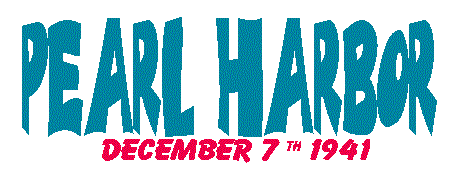
 WWII veteran (USS Kitkun Bay,
CVE-71)
Each token
in your collection, binds you to the past, to history. They whisper, " Don’t
forget!"
THE TOKENS:
PEARL HARBOR
DRIVERS’ ASSN. / P / T.H.
WWII veteran (USS Kitkun Bay,
CVE-71)
Each token
in your collection, binds you to the past, to history. They whisper, " Don’t
forget!"
THE TOKENS:
PEARL HARBOR
DRIVERS’ ASSN. / P / T.H.
GOOD FOR / P / ONE FULL FARE
Steel-round-21 millimeters (Coffee catalog number HI540D , book value $0.50, there are 6 different transit tokens listed from Pearl Harbor and 7 varieties) (T.H. on token means Territory of Hawaii) (Note the "pearls" inside the outline "P" on the obverse and reverse of the steel token are much more distinct than on the brass token below)


PEARL HARBOR DRIVERS’ ASSN. / P / T.H.
GOOD FOR / P / ONE FULL FARE
brass-round-21 millimeters (Coffee catalog number HI540B , book value $0.75, Cunningham number HI 170b similar)
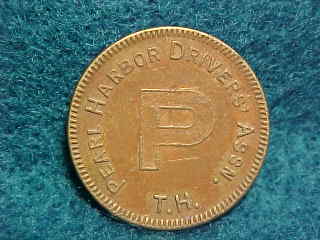
There are turning points in history, defining who we are today, what we might have been, and how we got here. Some of these moments are so unexpected, so shocking, that they remain in the national consciousness for decades. The Japanese attack on Pearl Harbor was one of those shocking moments.
THE GEOGRAPHYIn 1941, the Hawaiian Islands were a territory of the United States, strategic in their location near the middle of the Pacific Ocean. Pearl Harbor is located on the south side of the Island of Oahu. Ford Island is in the middle of Pearl Harbor. The United States had acquired exclusive rights to Pearl Harbor in 1887 by treaty.
THE PRELUDE TO THE ATTACK
On February 1, 1941 the United States Fleet, which previously had a battle fleet in the Pacific and scouting fleet in the Atlantic, was reorganized. The fleet in the Pacific became known simply as the Pacific Fleet, and the Atlantic Fleet became a separate entity. Also on that date, the permanent headquarters for the newly named Pacific Fleet became Pearl Harbor. The increase in activity at Pearl was intense, with the civilian work force at Pearl doubling between mid 1940 and mid 1941. The entrance to the harbor was widened and deepened, and the number of naval personnel increase dramatically. The entire Pacific Fleet could now easily be accommodated at Pearl independent of the mainland.
THE JAPANESE PLAN
By December of 1941. war had been raging in Europe for years; England was in a struggle for her life. America’s military was small. The U.S. depended mainly on its navy as a defensive force. The army was mainly a small force of professional soldiers. Japan was not then, the economic powerhouse it is today, and was not seen as a menace by most Americans. If war came, it was felt, it would come from Europe, from Hitler. The Japanese plan was based on Bushudo, and although strange to western minds, was simple and devised by Harvard educated Admiral Isoroku Yamamoto. The Japanese high command was convinced that war with the U.S. was inevitable. The object was to capture most of the western Pacific, South China Sea and associated landmasses. This extended as far as Sumatra, Java, New Guinea, Burma, Philippines, Thailand, Manchuria, and French Indochina. The plan to deal with the U.S was to cripple the Pacific Fleet with a surprise attack, and put up a defense around the conquered areas before the U.S could react. Japanese conquests in China and Southeast Asia had already forced the U.S. to freeze Japanese assets and implement an oil embargo against Japan.
THE ATTACK FORCE
The Japanese attack force was composed of 6 aircraft carriers, 2 battleships, 2 heavy cruisers, 9 destroyers, 1 light destroyer, 8 oilers and 3 "midget" submarines. The aerial force approached Hawaii from the north, the midget subs from the south.
THE ATTACK
As dawn broke on Sunday, December 7th 1941, none of America’s aircraft carriers were in port at Pearl Harbor. Battleship row was, however, lined with the most advanced battleships in the U.S. arsenal. During the night of December 6th, the 3 Japanese midget submarines had been launched, in order to penetrate the harbor and attack in coordination with the air raid planned for December 7th. In fact, the first enemy contact came at 0342 hours on Dec. 7th, when the USS Condor sighted a periscope of a midget sub, less than two miles outside of the harbor entrance. The USS Ward attacked the sub at 0645, with gunfire and depth charges, sinking it.
The first wave of Japanese aircraft consisted of 183 planes, launched at 0600 hours, arriving on the coast of Oahu at 0740. They flew into attack positions and Commander Mitsuo Fuchida radioed out code words to the Japanese carriers, which signaled that they had caught the U.S. Pacific Fleet by surprise: "TORA! TORA! TORA!" (TIGER! TIGER! TIGER!).
JAPANESE MILITARY TACTICS
The basic military tactics were simple. First strikes would cripple the American airfields, and Japanese fighters would fly "cap" for the bombers, to protect them. Japanese "Kate" torpedo planes would drop specially designed shallow running torpedoes against the battleships on the outboard side along "battleship row". Once the outboard ships were burning, high level bombers and dive-bombers would attack the inboard battleships. Spare ordinance was to be spent on targets of opportunity.
FORD ISLAND
The first bombs struck Ford Island at 0755 hours. At almost the same time, Japanese bombs and fighters struck Wheeler, Hickam, Ewa and Kaneohe fields. Within minutes, most of the American aircraft had been destroyed, eliminating the possibility of a threat to the attacking Japanese aircraft. Specially designed Japanese shallow running torpedoes were dropped from "Kate" aircraft against the US battlewagons, which were lined up with military precision along the northeast shore of Ford Island. At 0802 machine gun crews on board the USS Nevada (BB-36) opened fire on torpedo planes approaching her port beam, hitting two planes. At 0805 the repair ship Vestal (AR-4) opened fire. The battleship USS California (BB-44) was struck by a second torpedo portside. High level Japanese bombers began dropping armor piercing delayed action bombs from an altitude of 10,000 feet on the battleships below, scoring direct hits.
THE USS ARIZONA- SUNK IN 9 MINUTES
The largest number of casualties in the attack (1,177), and the most memorable loss to the United States, was incurred by the sinking of the battleship U.S.S. Arizona (BB-39).
USS Arizona 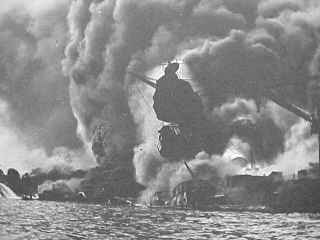 sunk and burning
sunk and burning
The battleship Arizona had it’s keel laid March 16, 1914, and was launched June 19, 1915. It was commissioned October 17, 1916. With a displacement of 37,654 tons and a speed of 20.70 knots, its twelve 14 inch guns were a fearsome sight to any enemy. It was named for the state of Arizona, and was the third U.S. ship to be so named. It was one of the first oil-burning battleships. Arizona’s original main propulsion system consisted of 12 boilers which powered four sets of turbines, each set of turbines driving a propeller shaft. As all U.S. naval ships, the Arizona underwent many overhauls, the last being in June of 1941, at Puget Sound Navy Yard. After the last overhaul, the ship had accommodations for 2,037 officers and enlisted men. After this overhaul, Arizona returned to her duty station at Pearl Harbor on July 8, 1941. A Japanese horizontal bombing attack plane hit the USS Arizona’s forecastle with a bomb, which detonated her forward magazines at approximately 0810 hours.
The devastating direct hit caused an explosion, which forced air through the ruptured fireroom sending a colossal plume of black smoke out the Arizona’s funnel. The Arizona foundered in 9 minutes, and burned for two and a half days. The sinking occurred so quickly that the majority of the crew were trapped below decks. Only 75 bodies of the 1,177 killed were recovered.
THE USS NEVADA-DASH FOR OPEN WATEROne event gave a tremendous boost to morale of U.S. forces, was the battleship USS Nevada’s (BB-36) attempt to get underway and escape the harbor. At 0840, the Nevada backed out of her berth, unassisted, and moved down the channel heading for the ocean. This would be difficult without smaller yard boats assisting her, and almost impossible due to the burning and exploding ships and attacking aircraft. Several Japanese planes broke off to attack the escaping Nevada, and she took bomb hits forward. Fires aboard the Nevada were intense, but she continued on toward the harbor entrance. More bombs hit her superstructure and boat deck. Burning fiercely, the Nevada ran aground at 0910 hours on Hospital Point.
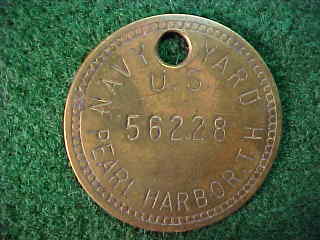
NAVY YARD/ U.S. / (numeral)/ PEARL HARBOR, T.H. (all incuse)
U/ (anchor)/ S / (all incuse, number ctsp.)
brass-round-35 millimeters (Cunningham number HI 180, Curto N120)
JOINING THE FRAY
The second wave of Japanese aircraft began attack run at 0850. The second wave consisted of 54 high level bombers mainly attacking the airfields, 78 dive bombers attacking the ships in Pearl, and 36 fighter aircraft circling the island maintaining air cover. Among the chaos, at 0900 hours, the Dutch ship Jagersfontein opened fire on the attacking Japanese planes, becoming the first of the Allies to join the fight. With ships and airfields burning across Oahu, at 0930 hours, a photographer snapped the well-known picture of the destroyer USS Shaw (DD-373) as the fires aboard the ship reached her powder magazines. A huge explosion and fireball engulfed the Shaw.
Reports of Japanese landing troops spread across the island by 1146 hours, and by 1210 hours, American planes were flying north from the island looking for enemy planes, with no results. The entire attack had lasted about two hours.
THE CASULTIES
A total of 2,409 Americans were killed in the attack, 1,178 were wounded. Of the killed, 2,004 were navy personal. A group of six F4F Wildcats from the USS Enterprise approached the harbor at 2110 (the night after the attack) being low on fuel were approaching Ford Island for landing when the entire harbor opened fire on them. Three of the Wildcat pilots survived, but the remaining 3 were killed due to "friendly fire".
MEDAL OF HONOR DECORATIONS
There were 14 Medals of Honor awarded for action at Pearl Harbor on December 7th, 1941. One of the MOH awards went to Chief Watertender Peter Tomich of the USS Utah. Tomich stayed below decks at his pumping station, as water flooded the ship, his manning of the pumps, allowed many of the trapped sailors aboard the Utah to scramble up to safety, but it cost Tomich his life.
RESULTS OF THE ATTACK
A wave of outrage swept the United States. War was declared, and volunteers for military service clogged recruiting offices. The red mist of anger clouded the eyes of most Americans. All things Japanese became hated, and if not hated, then suspect. Japanese-American citizens were even suspect, and internment camps to house them, were felt justified because of Pearl Harbor.
THE U.S.S. ARIZONA MEMORIAL
Today, as you read this, in the water of Pearl Harbor, small balls of fuel oil, slowly rise to the surface, from the wreck of the U.S.S Arizona, where they have been trapped for 58 years. The Arizona sits upright on the bottom of the harbor, with over 900 of her crew, still entombed within the ship (1,177 killed or missing). In 1961, fundraising efforts by the state of Hawaii, and various performers including Elvis Presley, culminated in the combination of private and federal funds for the construction of the present Arizona memorial.
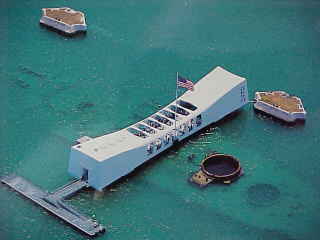
President Kennedy signed the legislation to appropriate funds in September of 1961. The architectural firm of Johnson, Perkins and Preis Associates was commissioned to design the memorial. The design was to span the sunken ship like a bridge, and not touch any portion of it. Dedication ceremonies took place on Memorial Day, 1962.
References: "Pearl Harbor, the way it was" by Goldstein, Dillon, Wenger, "Pearl Harbor and the USS Arizona Memorial" by Wisniewski.
Go to page 39 of our token web pages...
Back to page 1 of our token web pages....
updated 5 feb 2000